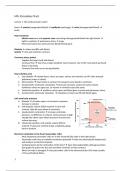Summary
Samenvatting van alle colleges - MG: Circulatory Tract (WBFA040-05)
- Course
- Institution
Summary of all MG circulatory tract courses (WBFA040-05) at the University of Groningen. All medications you need to learn before the exam are marked in red in the summary, making them easier to learn!!
[Show more]



